You know, exploring the top 10 candlestick patterns in technical analysis is like unlocking a door to a world of market insights.
Each pattern, from the Bullish Engulfing to the Three Black Crows, holds clues about potential price movements and trend shifts. Understanding these patterns can be a game-changer for traders looking to navigate the complexities of the market with more confidence.
So, are you ready to unravel the secrets behind these powerful candlestick formations and elevate your trading skills to the next level?
Bullish Engulfing Candlestick Pattern
The Bullish Engulfing Candlestick Pattern, composed of two candles, signifies a robust bullish reversal following a downtrend. This strong bullish pattern is characterized by the second candle completely overshadowing the first, indicating potential buying opportunities in the market.
It reflects a shift in market sentiment from bearish to bullish, with the second candle erasing the losses of the preceding one. Traders often seek confirmation of this pattern through increased volume and continued upward movement in prices.
Bullish Engulfing patterns are particularly powerful when they occur at crucial support levels or after an extended period of decline. Recognizing and acting upon these signals can be advantageous for traders looking to capitalize on potential uptrends in the market.
Bearish Engulfing Candlestick Pattern
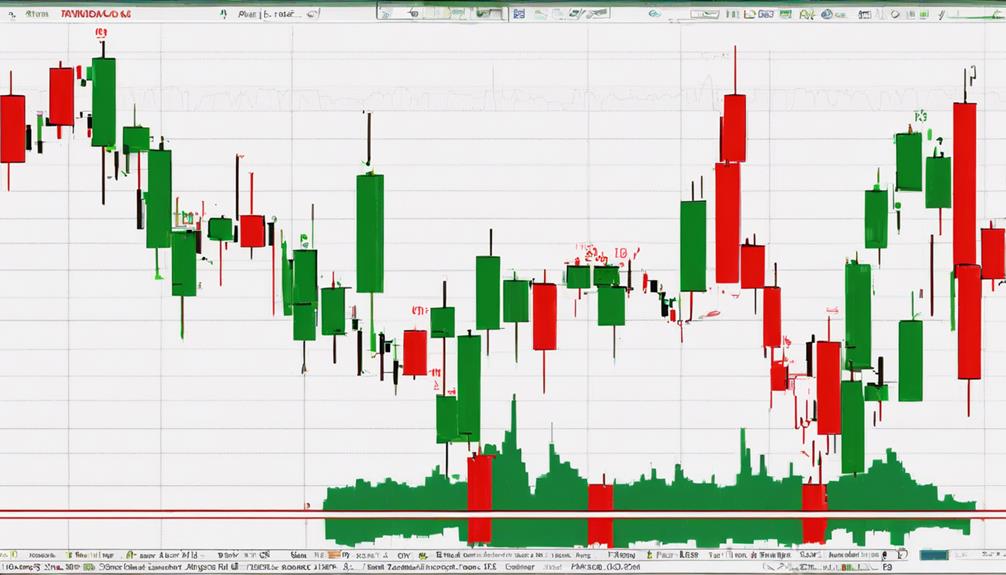
Following the robust bullish reversal pattern discussed in the previous subtopic, the Bearish Engulfing Candlestick Pattern represents a significant shift in market sentiment towards a potential downtrend. This bearish reversal pattern is characterized by the second candle completely engulfing the first, indicating a shift from buying to selling pressure.
Key points about the Bearish Engulfing pattern include:
- Consists of two candles, with the second candle fully engulfing the first.
- Signals a potential change in direction at the end of an uptrend.
- Traders interpret it as selling pressure surpassing buying pressure, suggesting a bearish sentiment takeover.
Monitoring subsequent price action is crucial to confirming the potential trend reversal indicated by the Bearish Engulfing pattern.
Morning Star Candlestick Pattern
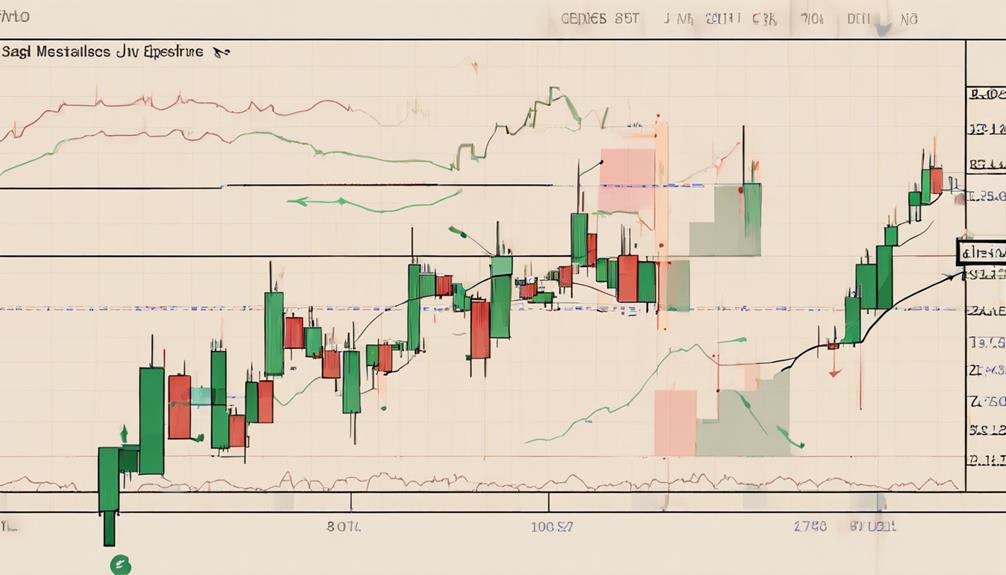
Exploring the Morning Star Candlestick Pattern reveals a three-candle formation signaling a potential bullish reversal in market sentiment.
This bullish reversal pattern begins with a long bearish candle, indicating a downtrend. The second candle is a small-bodied one or a doji, suggesting indecision in the market. Finally, the third candle is a bullish one that closes beyond the midpoint of the first candle, showing a shift towards bullish momentum.
Traders often seek confirmation signals, such as an increase in trading volume or a gap up on the next candle, to validate the pattern and strengthen their confidence in the potential trend reversal. The Morning Star Candlestick Pattern is a significant tool for traders looking to identify market reversals and capitalize on new uptrends.
Evening Star Candlestick Pattern
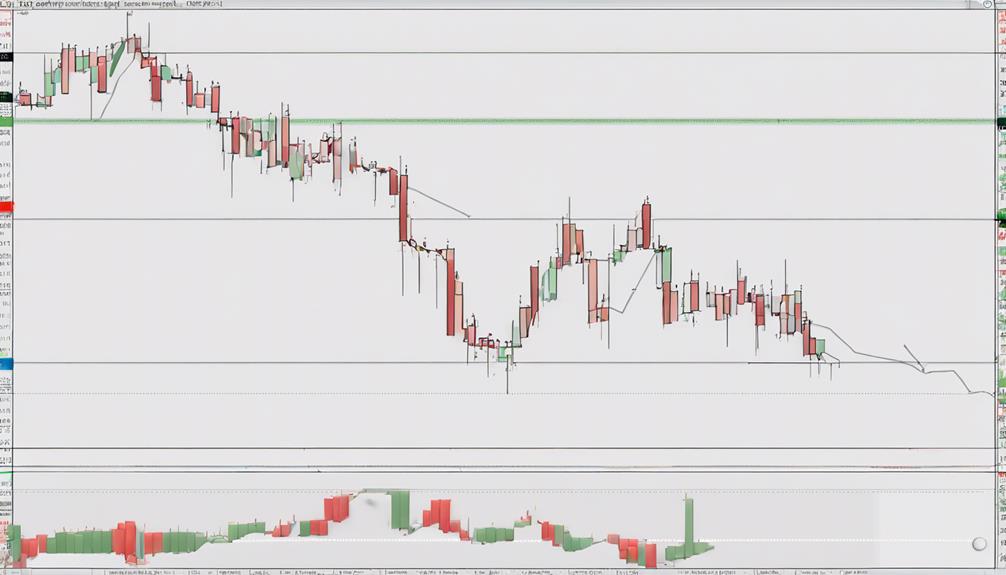
When analyzing candlestick patterns, the Evening Star is a significant bearish reversal signal due to its three-candle structure. It marks a potential shift from a bullish trend to a bearish one, often observed at the peak of an uptrend.
Traders typically seek confirmation of the pattern through a subsequent candle closing lower.
Bearish Reversal Signal
The Evening Star candlestick pattern, comprising three distinct candles, serves as a potent bearish reversal signal in technical analysis. This pattern typically starts with a large bullish candle, followed by a small-bodied candle or doji indicating indecision, and concludes with a large bearish candle.
- Distinct Sequence: The Evening Star pattern follows a specific sequence of candle formations.
- Trend Reversal: It indicates a potential shift in the trend from bullish to bearish.
- Confirmation: Traders often seek confirmation to validate the potential trend reversal after identifying the Evening Star pattern.
Three-Candle Pattern
After understanding the bearish reversal signal of the Evening Star candlestick pattern, let's now focus on the structure and characteristics of the Three-Candle Pattern.
The Three-Candle Evening Star pattern comprises three candles: a large bullish candle, a small-bodied candle or doji, and a large bearish candle. This pattern serves as a bearish reversal signal that commonly emerges at the conclusion of an uptrend, indicating a potential trend reversal.
The initial candle is bullish, followed by a second candle indicating indecision or a potential reversal, and finally, a third candle that solidifies the bearish sentiment by closing below the first candle.
Traders keenly observe the Evening Star pattern to predict a shift in market sentiment from bullish to bearish, often corroborating this pattern with other technical indicators for enhanced confirmation of potential downside movement.
Hammer Candlestick Pattern
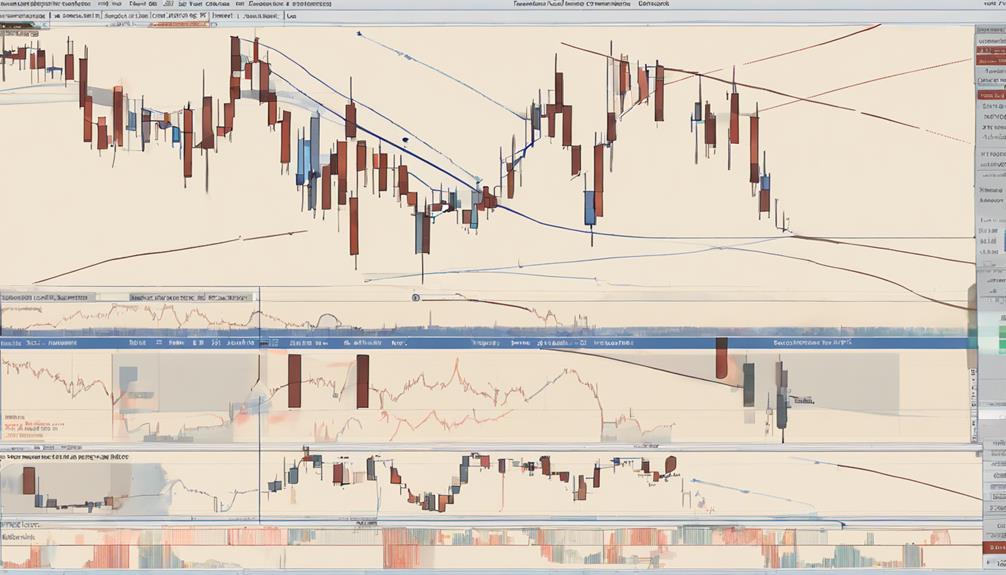
In the realm of technical analysis, understanding the Hammer Candlestick Pattern proves essential for identifying potential bullish reversals in market trends. Here are three key points about the Hammer pattern:
- The Hammer candlestick pattern is a bullish reversal signal that typically appears at the end of a downtrend, signaling a possible trend reversal.
- It's characterized by a small real body near the top of the candlestick and a long lower shadow, indicating that sellers drove prices down but were overpowered by buyers.
- Traders often wait for a confirmation candle to validate the potential bullish reversal indicated by the Hammer pattern, offering a chance to capitalize on the shift from bearish to bullish momentum.
Hanging Man Candlestick Pattern
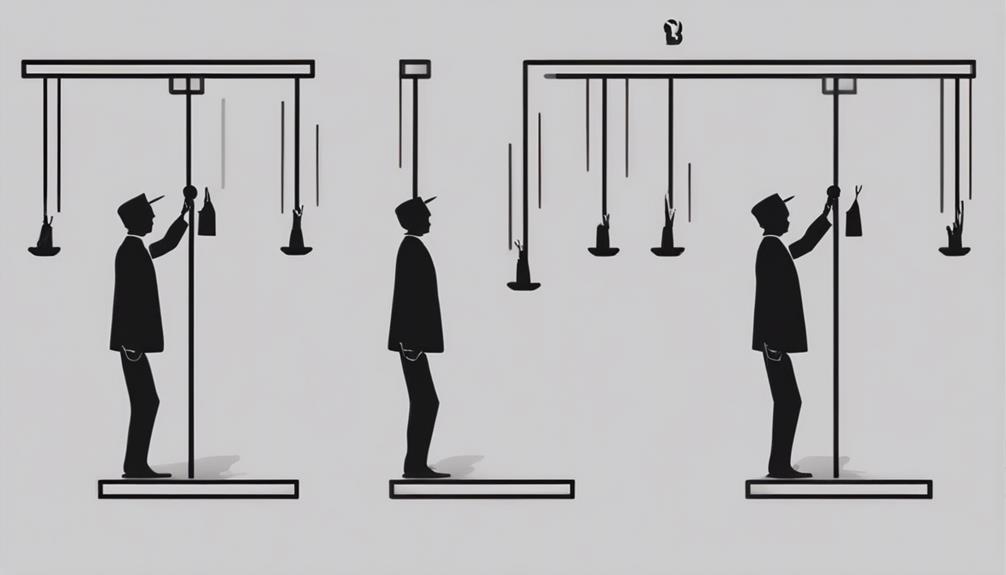
When analyzing candlestick patterns, understanding the meaning of the Hanging Man, identifying the pattern on a price chart, and interpreting its significance are key points to grasp.
The Hanging Man's small body, long lower shadow, and minimal upper shadow make it distinct, signaling a potential reversal in an uptrend.
It's crucial to observe follow-up price action and consider market conditions to validate the pattern's implications accurately.
Meaning of Hanging Man
The Hanging Man candlestick pattern, observed during an uptrend, indicates a potential bearish reversal in the market. This pattern is significant for traders as it can signal a shift in momentum from bullish to bearish.
Here are three key points about the Hanging Man candlestick pattern:
- Formation: It consists of a small real body near the bottom of the price range with a long upper shadow, resembling a person hanging.
- Market Sentiment: The pattern suggests that despite an initial push higher, buyers are losing control, and a potential trend reversal may be on the horizon.
- Confirmation: Traders typically look for a bearish candle following the Hanging Man to validate the potential reversal. Remember, analyzing the pattern within the broader market context is crucial for accurate interpretation.
Identifying the Pattern
Identifying the Hanging Man candlestick pattern involves recognizing a small real body near the session low with a distinct long upper shadow, resembling a hanging man. This pattern is a bearish reversal signal that typically appears at the end of an uptrend, signaling a potential trend reversal to the downside.
Traders often wait for confirmation by observing a lower opening on the next trading day after noticing the Hanging Man pattern. It's crucial to consider the overall market context and other technical indicators when using this pattern to make trading decisions.
Interpretation and Significance
At the end of an uptrend, the Hanging Man candlestick pattern signals a potential reversal with its small real body near the session low and a distinct long upper shadow. When interpreting this pattern, keep in mind that it indicates a possible trend reversal and can be a bearish signal. Here's why the Hanging Man pattern holds significance:
- Bearish Reversal: The Hanging Man pattern is a bearish reversal signal, suggesting that the uptrend may be losing momentum.
- Trend Reversal: Traders often see the Hanging Man as a sign that the current upward trend could be shifting to a downward trend.
- Confirmation: Traders typically wait for confirmation through a lower open or a gap down on the following candle to validate the bearish bias.
Doji Candlestick Pattern
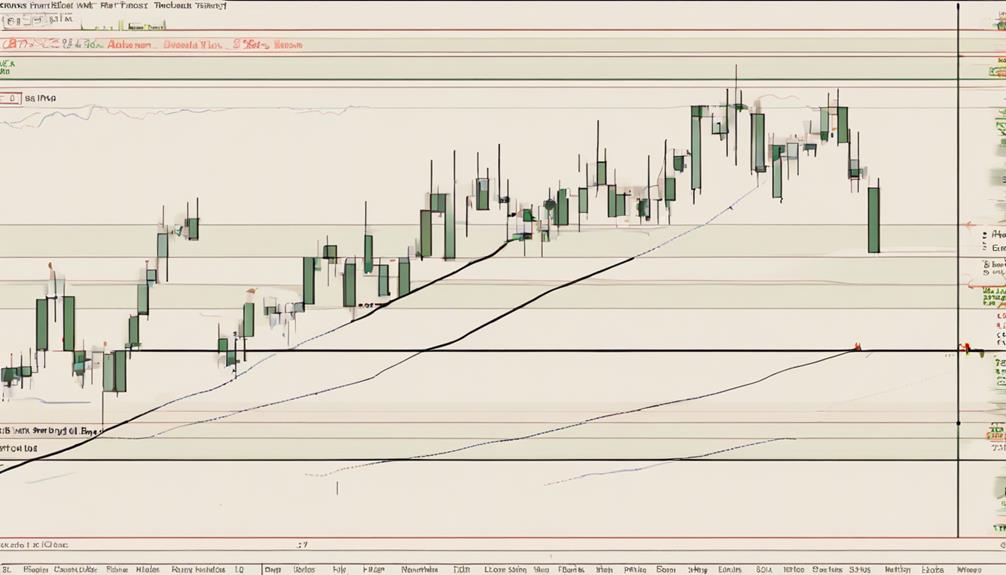
Navigating the complexities of the financial markets often involves recognizing the significance of a Doji candlestick pattern. A Doji candlestick represents market indecision, with the open and close prices being very close or even identical. This pattern suggests a potential trend reversal or continuation, depending on the surrounding price action.
Doji patterns can take on various forms such as long-legged, gravestone, or dragonfly types. Traders typically seek confirmation candles following a Doji to confirm the direction of the next market move. It's essential to understand the context and position of the Doji within a trend for accurate analysis and decision-making in trading scenarios.
Shooting Star Candlestick Pattern
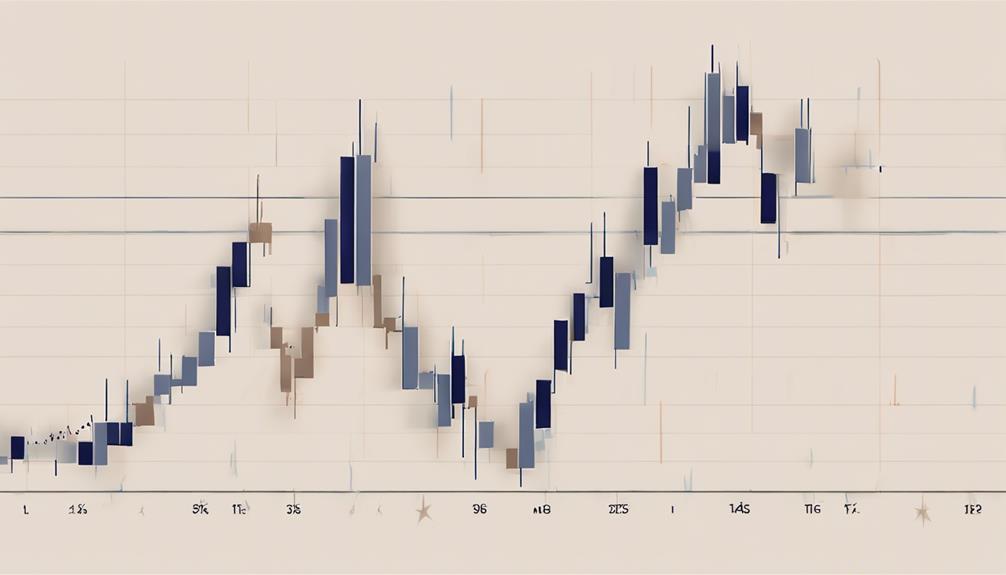
When observing the financial markets, recognizing the Shooting Star candlestick pattern can provide valuable insights into potential bearish reversals. Here are three key points to understand about this pattern:
- The Shooting Star candlestick pattern is a bearish reversal signal.
- It features a small real body near the bottom of the price range and a long upper shadow.
- This pattern indicates that buyers initially pushed the price up, but sellers managed to drive it back down by the close, signaling potential downward movement.
Traders often look for confirmation from subsequent candles to confirm the reversal suggested by the Shooting Star. It's particularly reliable when appearing after an uptrend, prompting traders to consider short positions.
Three White Soldiers Candlestick Pattern
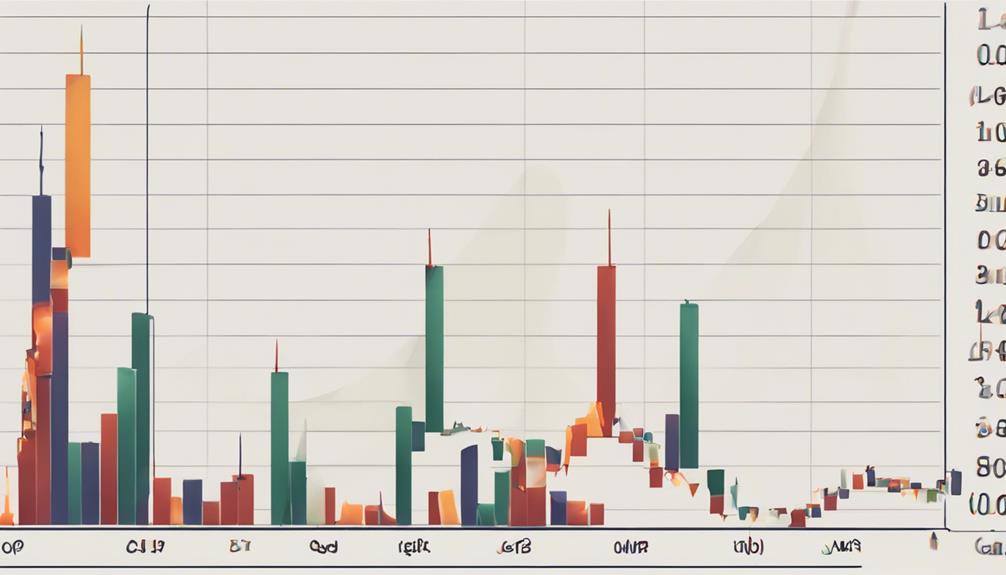
After understanding the Shooting Star candlestick pattern's bearish reversal signal, shift your focus to the Three White Soldiers candlestick pattern.
This pattern consists of three consecutive long bullish candles, indicating a strong buying pressure and signaling a potential bullish reversal. In each sequence, the candle should open within the previous candle's body and close near the high, reflecting a shift in momentum from bearish to bullish.
Traders keen on spotting trend reversals often watch for this pattern as a signal to enter long positions. The Three White Soldiers pattern serves as a visual representation of increasing dominance by buyers in the market, suggesting a shift towards a more positive outlook and a potential uptrend.
Three Black Crows Candlestick Pattern
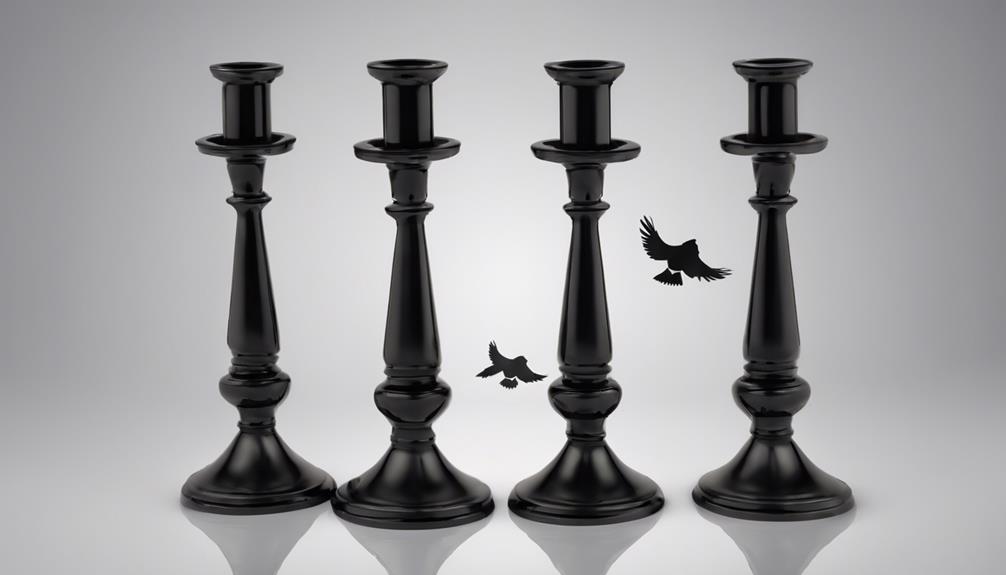
When you spot the Three Black Crows candlestick pattern on your chart, take note of its three consecutive long bearish candles opening higher than the previous day's close and closing lower.
This pattern signifies a strong downtrend, showcasing increasing selling pressure in the market. Traders often interpret this formation as a bearish reversal signal following a period of upward price movement.
Bearish Reversal Signal
Revealing a strong bearish reversal signal, the Three Black Crows candlestick pattern consists of three consecutive long bearish candles, each opening higher than the previous day's close and closing lower. This pattern indicates potential market weakness and a shift in control from buyers to sellers.
Here are key points about the Three Black Crows pattern:
- Three Consecutive Bearish Candles: Each candle is longer than the previous one, signifying increasing selling pressure.
- Higher Openings, Lower Closings: The pattern shows a consistent downtrend as each candle opens higher than the prior close and closes lower.
- Sellers in Control: The Three Black Crows suggest that sellers dominate the market, potentially leading to a prolonged downward trend.
Pattern Characteristics Explained
Exploring the characteristics of the Three Black Crows candlestick pattern reveals key insights into potential market shifts and trader sentiment. This bearish candlestick formation consists of three consecutive long bearish candles where each candle opens within the body of the previous one and closes near its low.
The Three Black Crows pattern typically indicates a strong bearish reversal or downtrend continuation. It often appears at the end of an uptrend, signaling a potential reversal of the prior bullish momentum. Traders keen on utilizing this pattern usually seek confirmation signals to bolster their trading decisions.
Observing these distinct features can aid traders in identifying potential opportunities for entering or exiting positions based on the Three Black Crows formation.
Could You Explain the Top 10 Candlestick Patterns in Technical Analysis in More Detail?
Sure, understanding the top 10 candlestick patterns in analysis is essential for technical traders. Patterns like hammer, doji, and engulfing can signal potential market reversals or continuations. These patterns can provide valuable insights into investor sentiment and help traders make more informed decisions.
Frequently Asked Questions
What Is the Most Successful Candlestick Pattern?
The most successful candlestick pattern is the Doji. It accurately predicts trend reversals, indicating market indecision or potential changes. Traders use it to stay out of the market or prepare for reversals. Its significance lies in balancing buyers and sellers.
What Is the 3 Candle Rule?
To understand the 3 Candle Rule, observe three consecutive candlesticks on a chart. Analyze patterns for trend reversals or continuations. This rule aids in assessing market sentiment, enhancing your ability to interpret price action and predict market movements.
How Do You Analyze Candlestick Patterns?
To analyze candlestick patterns, observe the shape, size, and color of candles on a chart. Look for patterns like doji or engulfing to predict market shifts. Study price relationships within candles and confirm with subsequent price actions.
What Do the Different Candlestick Patterns Mean?
To understand candlestick patterns, observe Doji for indecision, Hammer for bullish signals, Hanging Man for bearish trends. Engulfing patterns like Bullish Engulfing suggest strong reversals. Shooting Star and Inverted Hammer indicate potential changes. Piercing Line and Dark Cloud Cover confirm reversals.
Conclusion
In conclusion, mastering the top 10 candlestick patterns in technical analysis can greatly improve your ability to analyze market sentiment and make informed trading decisions.
Remember, 'the trend is your friend' when applying these patterns to identify potential trend reversals, continuations, and key levels in the market.
By incorporating these patterns into your trading strategies, you can enhance your skills and increase your chances of success in the financial markets.
